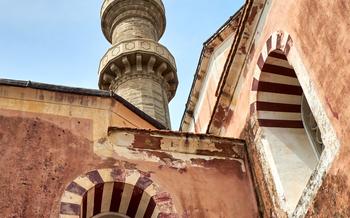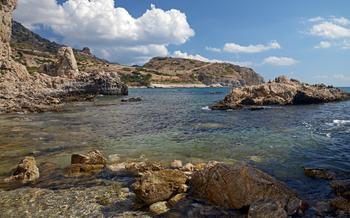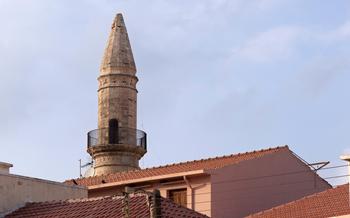
The Imaret of Komotini
- The Complex of the Imaret
- The Imaret Mosque
- The Madrasa of the Imaret
- The Tabhane of the Imaret
- The Imaret Today
- Visiting the Imaret of Komotini
- Things to Do at the Imaret
- What to See at the Imaret
- Where to Eat Near the Imaret
- Where to Stay Near the Imaret
- Getting Around Komotini
- Insider Tip
The Complex of the Imaret
The Imaret of Komotini is an extensive and diverse complex that encompasses numerous structures, each serving a specific function. The mosque, madrasa, and tabhane are the most prominent components of the complex. The mosque serves as a place of worship for the Muslim community and is renowned for its stunning architecture and intricate decorations. The madrasa was established as an educational institution to impart Islamic knowledge and teachings to students. The tabhane, on the other hand, functioned as a soup kitchen, providing sustenance and nourishment to the needy and underprivileged.
In addition to these core structures, the complex also features several auxiliary buildings and facilities. These include living quarters for the imam and other religious leaders, a library, a courtyard, and a garden. The courtyard, a central gathering space, serves as a venue for various religious and community events. The garden, with its lush vegetation and tranquil ambiance, offers a serene retreat from the bustling city streets.
The Imaret Mosque
The Imaret Mosque is a significant landmark within the Imaret complex, embodying both historical and religious importance for the Muslim community. Constructed during the same period as the rest of the complex, the mosque has stood as a testament to the architectural prowess and devotion of the Ottoman Empire.
The architectural style of the mosque blends seamlessly with the overall aesthetic of the Imaret, showcasing the characteristic Ottoman influences. The striking minaret, a symbol of Islamic architecture, rises majestically, inviting the faithful to prayer. Intricate carvings and calligraphy adorn the exterior, reflecting the artistry and craftsmanship that went into its construction.
Inside, the mosque exudes an air of tranquility and spirituality. The spacious prayer hall, with its rows of carpets facing towards Mecca, provides a serene environment for worshippers. The mihrab, a niche indicating the direction of Mecca, is adorned with intricate tilework, drawing the eye of the faithful during prayer. The pulpit, from which the imam delivers sermons, is another notable feature, showcasing the mosque's role as a center for religious guidance and learning.
The Imaret Mosque holds immense significance for the Muslim community, serving as a central place of worship and a symbol of their faith. It represents the rich cultural and religious heritage of the Ottoman Empire, and its enduring presence in Komotini continues to inspire devotion and reverence among the city's Muslim population.
The Madrasa of the Imaret
The madrasa, or Islamic school, was an integral part of the Imaret complex. It was founded in the 16th century by Lala Mustafa Pasha, who was the grand vizier of the Ottoman Empire at the time. The madrasa was intended to provide a comprehensive education to young Muslim boys from the region.
The curriculum of the madrasa included a wide range of subjects, including Arabic language and literature, Islamic law, mathematics, astronomy, and history. The students were also taught practical skills such as calligraphy and accounting. The madrasa was staffed by a team of highly qualified teachers, who were responsible for ensuring that the students received a well-rounded education.
The madrasa played an important role in the education system of the Ottoman Empire. It was one of the leading institutions of higher learning in the region, and its graduates went on to hold important positions in government, religion, and society. The madrasa also played a vital role in the social and cultural life of the city of Komotini. It was a meeting place for scholars and intellectuals, and it was a center for the dissemination of knowledge and culture.
The madrasa is still in operation today, and it continues to provide a valuable education to young Muslim students. It is a reminder of the rich history and culture of the Ottoman Empire, and it is a testament to the importance of education in Islamic society.
The Tabhane of the Imaret
The tabhane, or caravanserai, of the Imaret was a vital part of the complex, providing shelter and services to travelers and merchants. It consisted of a large courtyard surrounded by two-story buildings, with stables and storage facilities on the ground floor and guest rooms on the upper floor. The tabhane also had a kitchen, a dining room, and a mosque for the use of the guests.
The tabhane played an important role in the social and economic life of Komotini. It was a place where people from different parts of the Ottoman Empire could meet and exchange goods and ideas. It also provided a safe and comfortable place for travelers to rest and refresh themselves before continuing on their journey.
The tabhane of the Imaret is a reminder of the important role that Komotini played as a trading center in the Ottoman Empire. It is also a testament to the generosity and hospitality of the people of Komotini, who welcomed travelers and merchants from all over the world.
The Imaret Today
The Imaret complex is a well-preserved example of Ottoman architecture and is one of the most important historical and cultural sites in Komotini. It is currently used for a variety of purposes, including as a museum, a library, and a conference center. The mosque is still used for religious services, and the madrasa is still used for teaching Islamic studies.
The Imaret complex faces several challenges, including the need for ongoing maintenance and restoration, as well as the need to attract more visitors. However, the complex remains a significant landmark in Komotini and continues to play an important role in the city's cultural and religious life.
The Imaret complex is a must-see for anyone interested in the history, culture, and architecture of the Ottoman Empire. It is a beautiful and fascinating site that offers a glimpse into the past of Komotini.
Visiting the Imaret of Komotini
The Imaret of Komotini is a beautiful and historic complex that is well worth a visit. The best time to visit is during the spring or fall, when the weather is mild. The Imaret is open to the public daily, and the cost of admission is very reasonable. When visiting, be sure to dress modestly, as this is a religious site.
To get to the Imaret, you can take a taxi or public transportation. If you are driving, there is a parking lot available near the complex. Once you arrive, you can take a guided tour of the complex or explore on your own. Be sure to visit the mosque, the madrasa, and the tabhane. You can also visit the museum, which has a collection of artifacts from the Ottoman period.
Things to Do at the Imaret
The Imaret of Komotini offers a variety of activities and experiences for visitors. Visitors can take guided tours of the complex, which provide insights into its history, architecture, and significance. For those interested in learning more about the Ottoman Empire, the Imaret also houses a museum that exhibits artifacts and documents from that period.
In addition, visitors can attend religious services in the mosque, which is a unique opportunity to experience the vibrant Muslim community of Komotini. For those who want to delve deeper into the history and culture of the Ottoman Empire, there are also opportunities to learn about its art, music, and literature through lectures, workshops, and demonstrations.
What to See at the Imaret
The Imaret of Komotini is a stunningly beautiful complex, with a wealth of architectural details to admire. The courtyard is a peaceful oasis, with a fountain in the center and trees providing shade. The mosque is the most impressive building in the complex, with its soaring minaret and intricate carvings. The interior of the mosque is equally impressive, with its colorful tiles and stained-glass windows. The madrasa is a more modest building, but it is still worth a visit for its historical significance. The tabhane is a fascinating glimpse into the past, with its old-world charm and traditional Turkish architecture.
The beautiful architecture of the complex is one of its most striking features. The buildings are made from a variety of materials, including stone, brick, and wood. The intricate carvings and decorations add to the beauty of the complex. The stunning views from the roof of the mosque are not to be missed. On a clear day, you can see for miles in every direction. The peaceful atmosphere of the courtyard is a welcome respite from the hustle and bustle of the city.
Where to Eat Near the Imaret
Komotini offers a wide variety of dining options, from traditional Turkish restaurants to Greek tavernas and international cuisine restaurants. There are also many cafes and bars where you can relax and enjoy a drink.
If you are looking for a traditional Turkish meal, there are several restaurants near the Imaret that serve delicious kebabs, pide, and other Turkish specialties. For a more Greek experience, try one of the many tavernas in the city center. These tavernas serve classic Greek dishes such as moussaka, pastitsio, and souvlaki.
If you are looking for something different, there are also several international cuisine restaurants in Komotini. These restaurants serve dishes from all over the world, including Italian, Chinese, and Indian food.
No matter what your taste, you are sure to find something to your liking in Komotini. Be sure to try some of the local specialties, such as komotini pilaf and kadaif.
Where to Stay Near the Imaret
Komotini offers a variety of accommodation options for visitors, ranging from budget-friendly hostels to luxurious hotels. For those seeking a truly immersive experience, traditional guesthouses provide a glimpse into the local lifestyle.
-
Hotels: For a comfortable and convenient stay, there are several reputable hotels located near the Imaret. These hotels typically offer modern amenities, such as air conditioning, private bathrooms, and Wi-Fi, as well as convenient access to the city's many attractions.
-
Hostels: For budget-conscious travelers, there are several hostels within walking distance of the Imaret. These hostels provide basic accommodations, such as bunk beds in shared dormitories, but they also offer a social atmosphere and the opportunity to meet fellow travelers.
-
Apartments: For those seeking a more independent stay, there are several apartments available for rent near the Imaret. These apartments offer a kitchen and living area, providing guests with the convenience of preparing their own meals and relaxing in a home-like setting.
-
Guesthouses: For a truly authentic experience, consider staying at a traditional guesthouse. These guesthouses often offer unique accommodations, such as rooms with traditional Turkish décor, and the opportunity to interact with local families.
Getting Around Komotini
Komotini is a relatively small city, so it is easy to get around on foot. However, if you are staying further away from the city center, you may want to take advantage of the public transportation system. The city has a good bus network that connects all the major neighborhoods. You can also take a taxi, which is relatively inexpensive. If you are feeling adventurous, you can rent a bicycle or a car. Bicycles are a great way to explore the city, as there are many bike lanes and paths. Cars are also a good option, but be aware that parking can be difficult in the city center.
Insider Tip
To truly immerse yourself in the cultural significance of the Imaret, plan your visit during the annual Ramazan festival, also known as Ramadan. This holy month of fasting and prayer is a time of great spiritual reflection and communal celebration for Muslims worldwide. During this period, the Imaret comes alive with a vibrant atmosphere, as locals gather to break their fast together and share in the festivities. Experience the heartwarming hospitality and rich traditions of the Muslim community as they come together to celebrate this sacred occasion.



